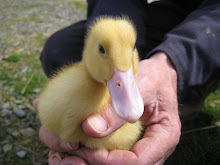 It's impossible to capture the power, the cacophony, the all pervasive wet in one wee photo, but Lydford Gorge's Devil's Cauldron is quite something. Some gentle pasture, a mild mannered woodland, and then boom! The cracked rock is full of tumbling, roaring, endless water moving at incredible velocity, gushing into the potholes below.
It's impossible to capture the power, the cacophony, the all pervasive wet in one wee photo, but Lydford Gorge's Devil's Cauldron is quite something. Some gentle pasture, a mild mannered woodland, and then boom! The cracked rock is full of tumbling, roaring, endless water moving at incredible velocity, gushing into the potholes below.The path is very much single track; no holding hands in holiday mood or chatting companionably side by side. You go down, down towards the mayhem and between the fissured stone into the depths of the gorge, secured either side by hand rails. Then a little swing gate and if you can brave the sudden lack of an outer handrail, soaked and slippy slate steps take you into the heart of the thing, where you stand on a platform right over the cauldron and imagine what it might have been like to be the first to discover this force of nature without a handhold to steady your body or spirit. I baulked and then set my jaw and completed the walk, strangely unaffected by vertigo, probably because everything is so contained and claustrophobic, quite unlike looking out from a high bridge or cliff into a world of scary nothing.
On the gentler parts of the walk, water constantly oozes and trickles, drips and splashes, spurts and springs through the ferns and mosses. Trees grow incredibly tall and straight seeking the light, and the undergrowth is an emerald and jade jungle - a cartel of chlorophyll. It's impossible to imagine going thirsty here; the antithesis of desert
The White Lady waterfall at the other end of the gorge is also beautiful if not so nervily dramatic, but the National Trust rather overdo the walker warnings calling it arduous, treacherous and goodness knows what else. You need stout shoes and a concentrating eye, and the dogs were left at home to avoid tipping anyone into the deadly depths, but although it's fairly steep, it's a short trot, and you couldn't compare it to climbing Everest.




















